wdk450
Well-known member
Gang:
I was particularly disturbed by a recent report of a Bighorn fire that was caused/accelerated by a reported broken rubber flex propane line in a kitchen slide that had been punctured/severed by tire fragments from a reported blowout. This could have just as easily been caused by tire fragments or other debris left on the road from other vehicles (think of all the truck tire fragments you see on the highways). Inspecting the hose under the kitchen slide on my BH 3670 showed me that it is very close to the left side tires and unprotected. Coming from a hospital equipment maintenence career, I know that although some events may have a slight risk of happening, still the consequences of that rare event can be grave. I resolved to improve the survivability of that flexible rubber gas line.
I first thought of using the ultimate flexible armor, flexible metal electrical conduit. Inspection at the haardware store showed it was difficult to get in a large enough size, didn't flex very well, would rust exposed to the road elements, and did not stay together well. I next moved over to the flexible hose aisle, and found some 1-1/4 inch I.D. PVC flex hose with woven nylon braid in the casing. This stuff felt hard and tough, yet flexible enough for the slide going in and out without pinching the rubber propane hose I was going to thread inside it.
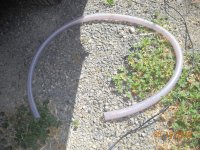
Installation: With the kitchen slide out, I turned off the propane gas supply, and used a 3/4" wrench to disconnect the flexible gas line fitting from the iron pipe. I then cut away the cable ties holding the hoses to the slide hose flex guide. I slid the new 1-1/4 inch PVC on over the existing rubber propane hose to the end of the hose on the slide outside wall. I then reconnected the rubber propane hose to the iron pipe flare fitting and tightened down the nut. I turned on the gas supply and checked for leaks at the connection with bubble solution. I then slid the outer hose forward up to the pipe grounding connector to provide some more mechanical connection for the outer hose. I then re-attached all of the hoses to the slide hose flex guide with cable ties. I finally tested the operation of the kitchen propane appliances with the slide both extended and in, to check for hose kinking. Everything works O.K.
Here are the before pics:
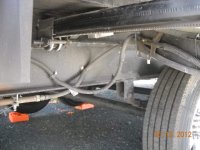
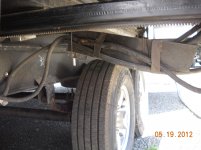
And here are the After Pics:
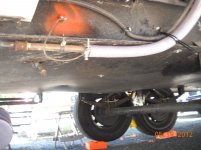
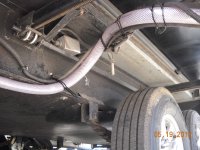
I was particularly disturbed by a recent report of a Bighorn fire that was caused/accelerated by a reported broken rubber flex propane line in a kitchen slide that had been punctured/severed by tire fragments from a reported blowout. This could have just as easily been caused by tire fragments or other debris left on the road from other vehicles (think of all the truck tire fragments you see on the highways). Inspecting the hose under the kitchen slide on my BH 3670 showed me that it is very close to the left side tires and unprotected. Coming from a hospital equipment maintenence career, I know that although some events may have a slight risk of happening, still the consequences of that rare event can be grave. I resolved to improve the survivability of that flexible rubber gas line.
I first thought of using the ultimate flexible armor, flexible metal electrical conduit. Inspection at the haardware store showed it was difficult to get in a large enough size, didn't flex very well, would rust exposed to the road elements, and did not stay together well. I next moved over to the flexible hose aisle, and found some 1-1/4 inch I.D. PVC flex hose with woven nylon braid in the casing. This stuff felt hard and tough, yet flexible enough for the slide going in and out without pinching the rubber propane hose I was going to thread inside it.

Installation: With the kitchen slide out, I turned off the propane gas supply, and used a 3/4" wrench to disconnect the flexible gas line fitting from the iron pipe. I then cut away the cable ties holding the hoses to the slide hose flex guide. I slid the new 1-1/4 inch PVC on over the existing rubber propane hose to the end of the hose on the slide outside wall. I then reconnected the rubber propane hose to the iron pipe flare fitting and tightened down the nut. I turned on the gas supply and checked for leaks at the connection with bubble solution. I then slid the outer hose forward up to the pipe grounding connector to provide some more mechanical connection for the outer hose. I then re-attached all of the hoses to the slide hose flex guide with cable ties. I finally tested the operation of the kitchen propane appliances with the slide both extended and in, to check for hose kinking. Everything works O.K.
Here are the before pics:


And here are the After Pics:


Last edited:
